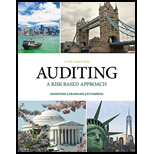
Auditing: A Risk Based-Approach (MindTap Course List)
11th Edition
ISBN: 9781337619455
Author: Karla M Johnstone, Audrey A. Gramling, Larry E. Rittenberg
Publisher: Cengage Learning
expand_more
expand_more
format_list_bulleted
Question
Chapter 5, Problem 44CYBK
To determine
Introduction: The supporting evidences gathered to support the assertion made by the management to check their accuracy are known as substantive evidence.
To define: The scenario where it is more likely to obtain substantive evidences.
Expert Solution & Answer
Want to see the full answer?
Check out a sample textbook solution
Students have asked these similar questions
expert of account question answer
General accounting
hello tutor provide solution san
Chapter 5 Solutions
Auditing: A Risk Based-Approach (MindTap Course List)
Ch. 5 - Prob. 1CYBKCh. 5 - Prob. 2CYBKCh. 5 - Prob. 3CYBKCh. 5 - Prob. 4CYBKCh. 5 - Prob. 5CYBKCh. 5 - Prob. 6CYBKCh. 5 - Prob. 7CYBKCh. 5 - Prob. 8CYBKCh. 5 - Prob. 9CYBKCh. 5 - Prob. 10CYBK
Ch. 5 - Prob. 11CYBKCh. 5 - Prob. 12CYBKCh. 5 - Prob. 13CYBKCh. 5 - Prob. 14CYBKCh. 5 - Prob. 15CYBKCh. 5 - Which of the following accounts would not be...Ch. 5 - Prob. 17CYBKCh. 5 - Prob. 18CYBKCh. 5 - Prob. 19CYBKCh. 5 - Which management assertion is usually most...Ch. 5 - Prob. 21CYBKCh. 5 - Prob. 22CYBKCh. 5 - Prob. 23CYBKCh. 5 - Prob. 24CYBKCh. 5 - Prob. 25CYBKCh. 5 - Prob. 26CYBKCh. 5 - Prob. 27CYBKCh. 5 - Prob. 28CYBKCh. 5 - Prob. 29CYBKCh. 5 - Prob. 30CYBKCh. 5 - Prob. 31CYBKCh. 5 - Prob. 32CYBKCh. 5 - Prob. 33CYBKCh. 5 - Prob. 34CYBKCh. 5 - Prob. 35CYBKCh. 5 - Prob. 36CYBKCh. 5 - Prob. 37CYBKCh. 5 - Prob. 38CYBKCh. 5 - Prob. 39CYBKCh. 5 - Prob. 40CYBKCh. 5 - Prob. 41CYBKCh. 5 - Prob. 42CYBKCh. 5 - Prob. 43CYBKCh. 5 - Prob. 44CYBKCh. 5 - Prob. 45CYBKCh. 5 - Prob. 46CYBKCh. 5 - Prob. 47CYBKCh. 5 - Prob. 48CYBKCh. 5 - Prob. 1RQSCCh. 5 - Prob. 2RQSCCh. 5 - Prob. 3RQSCCh. 5 - Prob. 4RQSCCh. 5 - Prob. 5RQSCCh. 5 - Prob. 6RQSCCh. 5 - Professional guidance indicates that the auditor...Ch. 5 - Identify the accounts associated with the...Ch. 5 - Assume that an organization asserts that it has...Ch. 5 - Prob. 10RQSCCh. 5 - Prob. 11RQSCCh. 5 - Prob. 12RQSCCh. 5 - Prob. 13RQSCCh. 5 - List factors that might affect an audit firm’s...Ch. 5 - Prob. 15RQSCCh. 5 - Prob. 16RQSCCh. 5 - Prob. 17RQSCCh. 5 - Prob. 18RQSCCh. 5 - Prob. 19RQSCCh. 5 - Prob. 20RQSCCh. 5 - Prob. 21RQSCCh. 5 - Prob. 22RQSCCh. 5 - Prob. 23RQSCCh. 5 - Prob. 24RQSCCh. 5 - Prob. 25RQSCCh. 5 - Prob. 26RQSCCh. 5 - Prob. 27RQSCCh. 5 - Prob. 28RQSCCh. 5 - Prob. 29RQSCCh. 5 - Prob. 30RQSCCh. 5 - Prob. 32RQSCCh. 5 - Prob. 33RQSCCh. 5 - Prob. 34RQSCCh. 5 - Prob. 35RQSCCh. 5 - Prob. 36RQSCCh. 5 - Prob. 37RQSCCh. 5 - Prob. 38RQSCCh. 5 - Prob. 39RQSCCh. 5 - Prob. 40RQSCCh. 5 - Prob. 42RQSCCh. 5 - Prob. 43RQSCCh. 5 - Prob. 44FF
Knowledge Booster
Similar questions
- chose best answer plzarrow_forward?? Financial accountingarrow_forwardA firm has a market value equal to its book value. Currently, the firm has excess cash of $1,000, other assets of $5,500, and equity of $6,500. The firm has 650 shares of stock outstanding and a net income of $600. The firm has decided to spend half of its excess cash on a share repurchase program. How many shares of stock will be outstanding after the stock repurchase is completed? a. 625 shares b. 640 shares c. 600 shares d. 630 shares e. 615 sharesarrow_forward
- Provide correct answer general accounting questionarrow_forwardanswer plzarrow_forwardThe controller of Afton Manufacturing has collected the following monthly expense data for use in analyzing the cost behavior of maintenance costs: ⚫ January: $2,800 and 3,500 machine hours • February: $3,200 and 4,200 machine hours ⚫ March: $3,800 and 6,000 machine hours ⚫ April: $4,500 and 7,500 machine hours • May: $3,600 and 5,200 machine hours • June: $5,200 and 7,000 machine hours Using the high-low method, determine the estimated fixed cost element and the variable cost per unit of machine hour.arrow_forward
- Subject general accountingarrow_forwardFinancial accountingarrow_forwardDelta Corp. had the following data last year: • Net income = $1,200 • Net operating profit after taxes (NOPAT) = $1,100 • Total assets = $4,500 Total operating capital = $3,500 For the just-completed year, Delta Corp. reported: • Net income = $1,500 • NOPAT = $1,375 • Total assets = $3,800 Total operating capital = $3,900 How much free cash flow (FCF) did Delta generate during the just-completed year?arrow_forward
arrow_back_ios
SEE MORE QUESTIONS
arrow_forward_ios
Recommended textbooks for you
 Auditing: A Risk Based-Approach (MindTap Course L...AccountingISBN:9781337619455Author:Karla M Johnstone, Audrey A. Gramling, Larry E. RittenbergPublisher:Cengage Learning
Auditing: A Risk Based-Approach (MindTap Course L...AccountingISBN:9781337619455Author:Karla M Johnstone, Audrey A. Gramling, Larry E. RittenbergPublisher:Cengage Learning Auditing: A Risk Based-Approach to Conducting a Q...AccountingISBN:9781305080577Author:Karla M Johnstone, Audrey A. Gramling, Larry E. RittenbergPublisher:South-Western College Pub
Auditing: A Risk Based-Approach to Conducting a Q...AccountingISBN:9781305080577Author:Karla M Johnstone, Audrey A. Gramling, Larry E. RittenbergPublisher:South-Western College Pub

Auditing: A Risk Based-Approach (MindTap Course L...
Accounting
ISBN:9781337619455
Author:Karla M Johnstone, Audrey A. Gramling, Larry E. Rittenberg
Publisher:Cengage Learning

Auditing: A Risk Based-Approach to Conducting a Q...
Accounting
ISBN:9781305080577
Author:Karla M Johnstone, Audrey A. Gramling, Larry E. Rittenberg
Publisher:South-Western College Pub